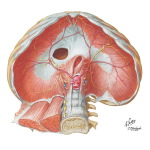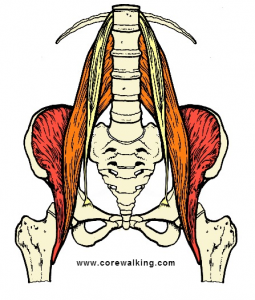Walking and breathing are intimately connected through the psoas muscle and the diaphragm muscle. The psoas major is the main muscle of walking, an action ideally initiated deep in the core of the trunk. The psoas connects the spine to the legs attaching on the lower spine (T12, L1-4), before crossing the rim of the pelvis to attach on the back half of the inner thigh. The psoas muscle, if properly aligned is capable of supporting and moving us through space. Its downward pull on the front of the lower spine allows many muscles at the back of the body to lengthen and tone upwards providing support for the head at the top of the spine. When walking it is the work of the two psoas muscles moving in opposition that stimulates a natural and healthy rotation in the pelvis and throughout the spine. Most people use their big thigh muscles (quadriceps) to pull them through life but if everything works according to design the psoas is generating our movement and many overworked muscles get to relax.
The diaphragm muscle, a dome shaped muscle at the base of the ribcage, is the essential muscle of breathing. When we inhale the diaphragm is meant to descend allowing air to be drawn into the expanding lungs. At the base of the pelvis three layers of muscle support the weight of the organs. These pelvic muscles and the diaphragm work synergistically connecting walking and breathing with every successful step. With each inhalation the diaphragm and pelvic floor should lower and with each exhale they should rise back up moving the contents of the trunk with them. Add to this up and down movement the rotational possibilities of the psoas when walking, and every breath and every step we take can tone and massage the entire contents of the trunk.
There are also relationships between the psoas muscle and the diaphragm muscle that literally connect the acts of walking and breathing. There are two tendons for the diaphragm called the crura that extend down and connect to the spine right alongside the psoas attachment. One of the ligaments of the diaphragm (medial arcuate) wraps around the top of the psoas. Finally the diaphragm and the psoas connect through fascia, the webbing that encases the body in both safe and sorry ways. There is a particular fascial grouping that joins the diaphragm, psoas and other hip muscles.
The relationship between these two titans of walking and breathing cannot be understated. Health in one can and will encourage health in the other.
***


